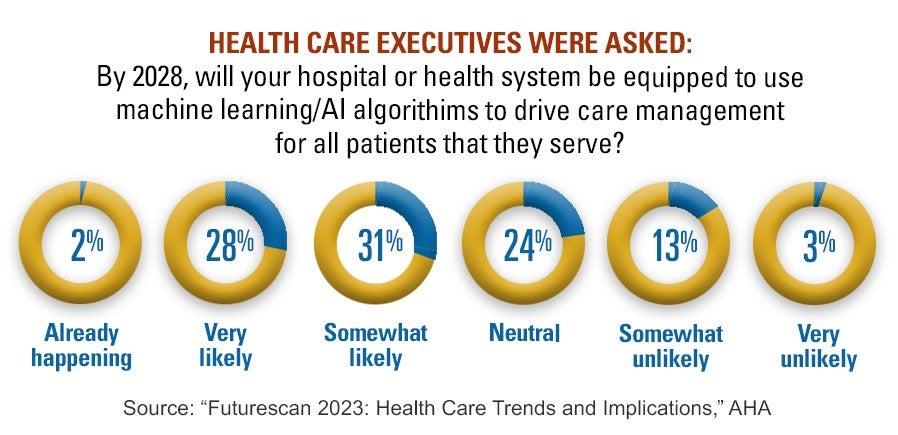

How to Personalize Care across Four Generations of Patients

Health care organizations have become increasingly more sophisticated in how they collect, analyze and use patient-experience data to personalize and improve care delivery.
These capabilities will be even more important in the years ahead as providers respond to growing competition from retail health care disruptors that have built long-term relationships with consumers and have deep insights into their personal preferences.
Over the next five years, hospitals and health systems will need to make greater use of artificial intelligence (AI) and patient data to glean valuable insights that can help them differentiate their services, according to AHA’s recently released Futurescan 2023.
Developed by the AHA’s Society for Health Care Strategy & Market Development in collaboration with the American College of Healthcare Executives, Futurescan 2023 provides insights from thought leaders across eight topic areas, including workforce trends, health equity, the competitive environment and more. Each report is supported with data from a 2022 survey of health care leaders.
Leverage AI to Personalize Care
Delivering more personalized health care depends on being able to segment and understand the differences in experiences among age, racial and ethnic groups, notes Chrissy Daniels, chief experience officer of Press Ganey Associates. Daniels and her colleague Joan Kelly partner in strategic planning at Press Ganey, provide insights on age generations and other important demographic groups such as the LBGTQ+ community and people of color.
“Creating personalization in health care is reliant upon being able to segment and understand the differences in experiences, rather than the aggregation of experiences,” Daniels notes.

The use of AI will be critical to this effort, the authors state. The latest Futurescan survey data show that most responding organizations are in the middle of this journey. Fifty-nine percent said it was very likely or somewhat likely that their organization would be equipped to use machine learning or AI algorithms to drive care management for all their patients by 2028; only 2% report already using AI.
Key Takeaways to Personalize Care by Generation
Health care executives will need to know the current experiences among various generational cohorts and how to meet their specific needs, including:
1 | Baby Boomers (born between 1946 and 1964)
This unique group wants the best and their demands have transformed areas like senior living, leisure and recreation. Concierge and luxury health care emerged because baby boomers want high-touch services, Daniels says, noting that this creates a growth opportunity for health care organizations.
Takeaway
Baby boomers have a high degree of confidence in brands that convey quality and are willing to pay for name-brand patient experiences. As a result, the market for destination medicine is likely to grow.
2 | Gen X (born between 1965 and 1981)
Gen Xers are a silent but emerging demographic for patient acquisition, Kelly says. This cohort, more than any other, is handling multigenerational patient direction for their own children and often their parents. Health care organizations will need to respond by coordinating care in a family-convenient way.
Takeaway
As more care moves into the home setting and family members take on a greater role as caregivers, Gen Xers will need more support from health care organizations.
3 | Millenials (born between 1981 and 1996)
Now the largest living adult generation in the U.S., millennials generally have been healthy and less insured than earlier cohorts. They value convenience first and foremost. They look for care close to where they want to receive it, need to know wait times, want to be able to message providers and find hours and reviews online.
Takeaway
Identifying all the locations affiliated with your organization and optimizing your presence on Google Maps has never been more important, Kelly says.
4 | Gen Z (born between 1996 and 2012)
This age bracket has the highest percentage of young adults living at home in the post-World War II era, Daniels notes. They are likely to be covered by their parents’ health insurance and often defer care decisions to their mothers. They are comfortable with both virtual care and text-based care and are less likely to engage in face-to-face, in-person care.
Takeaway
This generation is more willing to seek care for behavioral health issues, particularly among transgender individuals, Daniels says. These individuals don’t separate physical and mental health, and access behavioral health at a much younger age than other generations.



